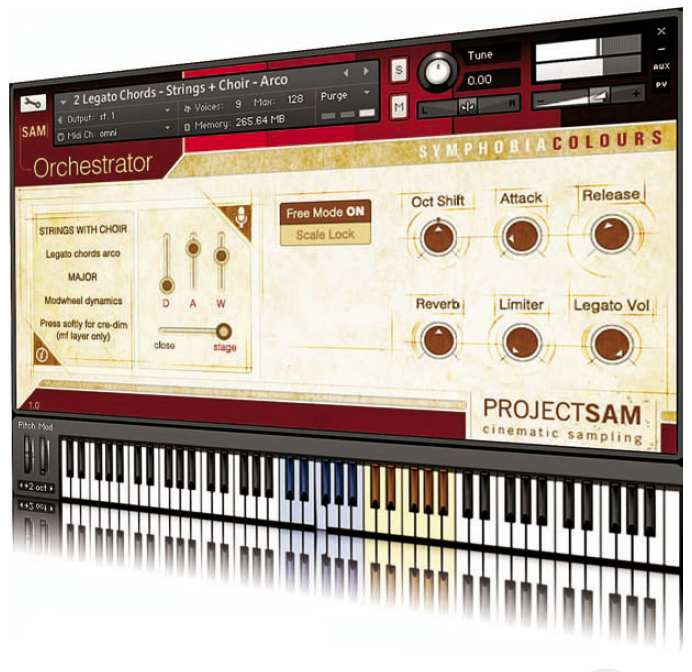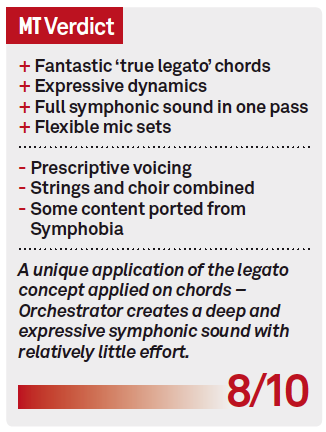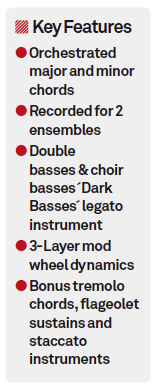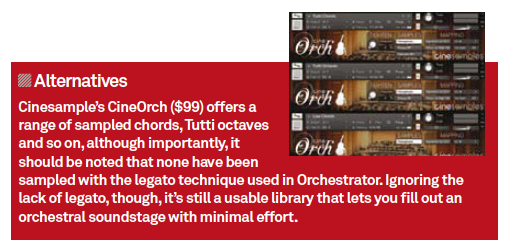ProjectSAM’s Symphobia Orchestrator Review
ProjectSAM’s new Symphobia Colours series takes a more affordable, focused approach to cinematic sampling. Mark Cousins meets the Orchestrator… Details Manufacturer – ProjectSAM Price – £169 Contact – Time + Space 0183755200 Web – www.projectsam.com Requirements – Kontakt 5.3 or Kontakt Player 5.3 (requires OS X10.7 or higher (Mac) or Windows 7 or 8) Amazon.co.uk Widgets Having […]

ProjectSAM’s new Symphobia Colours series takes a more affordable, focused approach to cinematic sampling. Mark Cousins meets the Orchestrator…

Details
Manufacturer – ProjectSAM
Price �– £169
Contact – Time + Space 0183755200
Web – www.projectsam.com
Requirements – Kontakt 5.3 or Kontakt Player 5.3 (requires OS X10.7 or higher (Mac) or Windows 7 or 8)
Having created some of the finest sample-based orchestral instruments of the last 10 years, ProjectSAM has an enviable reputation at delivering a truly cinematic sound, arguably best encapsulated in the company’s excellent Symphobia series. However, none of the Symphobia instruments have been particularly affordable, but the Symphobia Colours series changes this by offering smaller, more focused libraries that build on the concepts developed throughout the originals.
The Orchestrator
Symphobia Colours includes two instruments: Orchestrator, on test here, and Animator, which we’ll look at in a future issue. With both, the scope is smaller than we’re used to and focuses on a particular technique or facet of the orchestral sound palette. In Orchestrator’s case, the concept is firmly on legato chords – sampled with strings and choir, and wind and brass combinations – alongside other value-added content (some ported from the original Symphobia series) that helps extend the musical potential.
Monophonic ‘true legato’ should be a familiar concept to any musicians working with orchestral samples, but the possibilities of legato chords may be a new experience. With monophonic lines, a true legato instrument uses a transitional sample to move from one note to the
next, capturing the realistic portamento-like effect as one note slides to the next. With chords, the concept is similar, but here ProjectSAM has sampled the transition from a C to an F, for example, or from Am to Fm.
Symphonic Chords
The concept and sound of Orchestrator is immediately apparent. The keyboard is divided between major chords across one octave and minor chords in another – simply move between the appropriate single notes and Orchestrator will produce a smooth, sumptuous transition between the different chords. The Mod Wheel can be used to add dynamic movement (great for a crescendo and diminuendo over the length of the chord) and you can also move between three different microphones sets to change the perspective of the orchestra.
You also get a collection of legato double basses, plus various non-legato sustains, chords and staccatos that can be accessed as individual instruments, or as part of an impressive collection of multi instruments. These demonstrate the full symphonic potential, creating a full orchestral sound palette, with dynamics from just a single pass on a keyboard. If you’ve experienced any of the excellent multis found in Lumina, you’ll know what to expect.
Easy Orchestra
As with many of these orchestral libraries, there’s a balance to strike between some ingenious sampling that delivers hyper-realistic results, and a tool that confines and restricts your musical creativity. In some respects, Orchestrator is somewhat prescriptive in the result it creates – with aspects like the chord voicing and instrument selection somewhat defined for you. It might have been nice to have strings separate from choir, although the combination of wind and brass is certainly a nice pairing with plenty of musical potential!
There’s little doubt that Orchestrator can deliver excellent results, with the performance legatos really adding to the realism. There are also some great serendipitous results to be had when playing Orchestrator’s chords in a free-form way.
Ultimately, Orchestrator forms part of a palette of tools and techniques, something that enhances and expands an existing orchestral soundstage, rather than a one-stop-shop for the entirety of your composition process.





